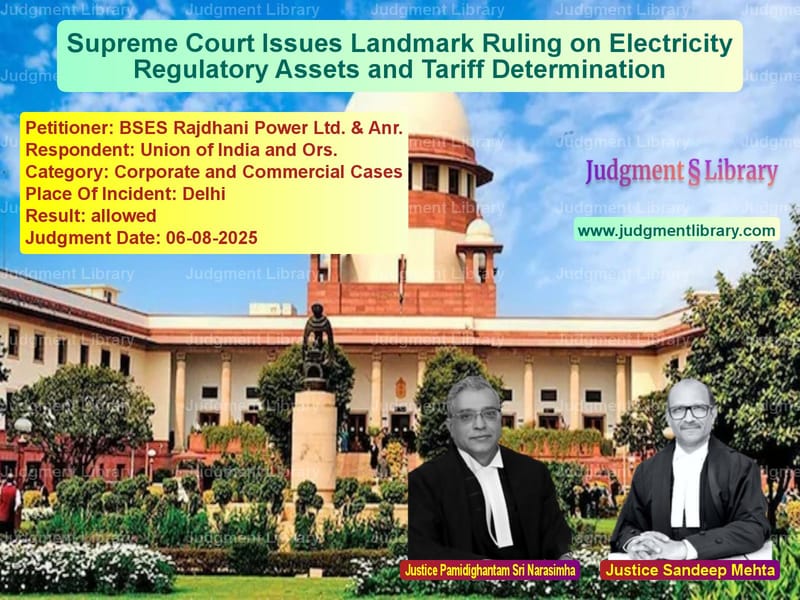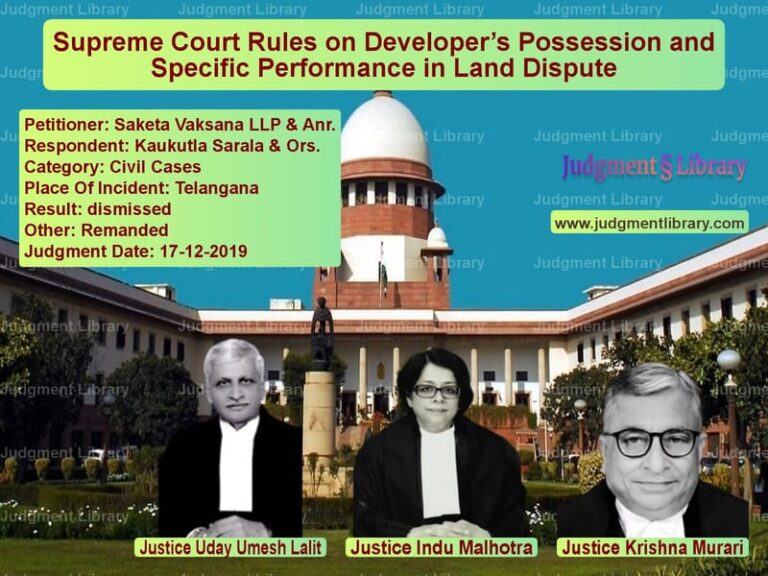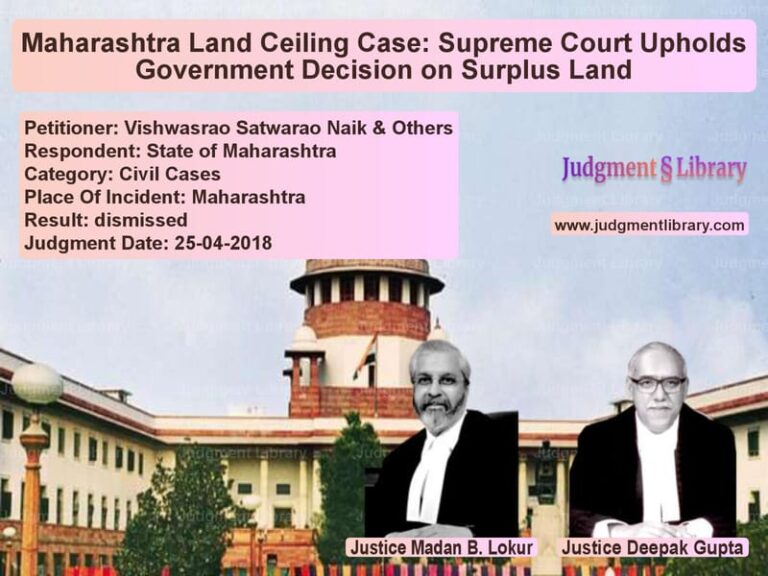Supreme Court Issues Landmark Ruling on Electricity Regulatory Assets and Tariff Determination
In a landmark judgment with far-reaching implications for India’s power sector, the Supreme Court has delivered a comprehensive ruling on the controversial issue of ‘regulatory assets’ – a financial mechanism that has burdened electricity distribution companies and consumers alike. The case, which involved Delhi’s three major power distribution companies – BSES Rajdhani Power Ltd, BSES Yamuna Power Ltd, and Tata Power Delhi Distribution Limited – against regulatory authorities and government bodies, addressed the growing concern of accumulated regulatory assets totaling over Rs. 27,200 crores in Delhi alone.
The Court’s ruling came after extensive hearings that involved not just the immediate parties but also various State Electricity Regulatory Commissions and State Governments across India, highlighting the national significance of the issue. The judgment, delivered by a bench comprising Justice Pamidighantam Sri Narasimha and Justice Sandeep Mehta, establishes crucial principles governing the creation, management, and liquidation of regulatory assets while emphasizing the need for cost-reflective tariffs and regulatory accountability.
The core issue before the Court was whether the Delhi Electricity Regulatory Commission (DERC) had properly exercised its regulatory powers in creating and managing regulatory assets over nearly two decades. The distribution companies argued that the continuous accumulation of regulatory assets without proper liquidation mechanisms had severely impacted their financial health and violated the principles of the Electricity Act, 2003.
Mr. Kapil Sibal, representing the distribution companies, made compelling arguments about the statutory framework. He submitted that “the statute intends to distance the government from tariff regulation and determination by establishing independent regulators, and it aims to encourage private sector participation in the electricity sector.” He emphasized that the conditions for creating regulatory assets as per Clause 8.2.2 of the National Tariff Policy had not been complied with by DERC.
Dr. Abhishek Manu Singhvi, appearing for TPDDL, highlighted the practical implications, stating that “to liquidate the regulatory asset, certain measures may be taken such as increasing the Deficit Recovery Surcharge, increasing tariffs payable by consumers, and through government support.” He stressed the need for fixed timelines as the quantum of regulatory assets only increases with time due to accumulating carrying costs.
The DERC, represented by Mr. Nikhil Nayyar, defended its position by tracing the history of regulatory asset creation and the various measures taken to address the issue. He submitted that “the DERC’s tariff order dated 11.06.2004 shows that the BSES Discoms themselves suggested the creation of a regulatory asset to enable recovery of the revenue gap over a period of time through gradual increase in tariffs.” He also pointed to external factors like unprecedented increases in power purchase costs, which constituted more than 80% of the tariff.
The Ministry of Power, through Mr. K.M. Nataraj, learned ASG, supported the distribution companies’ position, stating that “a regulatory asset is created when State Commission determines tariffs while ignoring the principles laid down in Section 61 of the Electricity Act.” The Ministry emphasized the need for time-bound liquidation in accordance with the newly introduced Rule 23 of the Electricity Rules.
After considering all arguments and examining the legal framework, the Supreme Court delivered a comprehensive analysis of the regulatory landscape. The Court observed that “Electricity is a public good. Its generation, transmission, and distribution are statutorily regulated to ensure access to supply, on a non-rival and non-exclusive basis.” This fundamental recognition set the stage for the Court’s detailed examination of regulatory responsibilities.
The Court explained the concept of regulatory assets in simple terms: “A ‘regulatory asset’ in the context of tariff determination for electricity utilities is an intangible asset that is created by the Regulatory Commissions in recognition of an uncovered revenue gap or revenue shortfall when a distribution licensee could not fully recover the costs reasonably incurred by it through revenue from tariff.” The Court noted that this mechanism is adopted to prevent ‘tariff shock’ to consumers when immediate recovery of costs would lead to substantial tariff hikes.
However, the Court expressed serious concern about the mismanagement of regulatory assets, stating that “Disproportionate increase and long pending regulatory asset depict a ‘regulatory failure’. It has serious consequences on all stakeholders and the ultimate burden is only on the consumer.” This strong observation highlighted the Court’s recognition of the consumer’s ultimate burden in such regulatory failures.
The Court extensively analyzed the legal framework governing regulatory assets, including the Electricity Act, 2003, National Tariff Policies of 2006 and 2016, and the recently introduced Rule 23 of the Electricity Rules, 2024. The Court emphasized that “The creation of a regulatory asset, being a measure undertaken by the Regulatory Commissions as part of tariff determination, such exercise is informed by Section 61 read with Sections 79 and 86.”
In its most significant observations, the Court outlined the principles that must govern regulatory assets: “As a first principle, tariff shall be cost-reflective; The revenue gap between the approved Annual Revenue Requirement and the estimated annual revenue from approved tariff must be only in exceptional circumstances; The regulatory asset should not exceed a reasonable percentage… If a regulatory asset is created, it must be liquidated within a period of 3 years… The existing regulatory asset must be liquidated in a maximum of 7 years.”
The Court also emphasized the accountability of Regulatory Commissions, noting that “A Regulatory Commission must perform its functions as per the provisions of the Electricity Act, the National Electricity Policy, the National Tariff Policy, the relevant rules and regulations made under the Act, and the APTEL’s directions.” The Court reinforced the powers of the Appellate Tribunal for Electricity (APTEL) under Section 121 of the Electricity Act to issue directions to Regulatory Commissions for proper performance of their statutory functions.
In its final directions, the Court established a clear framework for dealing with regulatory assets: “The existing regulatory asset must be liquidated in a maximum of 4 years starting from 01.04.2024… Regulatory Commissions must provide the trajectory and roadmap for liquidation of the existing regulatory asset, which will include a provision for dealing with carrying costs.” The Court also directed APTEL to monitor the implementation of these directions through suo moto proceedings.
The judgment represents a significant step toward financial discipline in the power sector. By establishing clear timelines and principles for regulatory asset management, the Court has balanced the interests of distribution companies, consumers, and the broader public interest in a sustainable electricity sector. The ruling is expected to have nationwide implications as several states, including Tamil Nadu, Rajasthan, Kerala, and Maharashtra, are facing similar challenges with accumulated regulatory assets.
This landmark decision reinforces the Supreme Court’s role in ensuring regulatory accountability and protecting consumer interests while recognizing the practical challenges faced by power distribution companies. The principles established in this judgment are likely to shape tariff determination and regulatory practices across India’s electricity sector for years to come, promoting financial sustainability while ensuring that the burden of regulatory failures does not indefinitely fall on consumers.
Petitioner Name: BSES Rajdhani Power Ltd. & Anr..Respondent Name: Union of India and Ors..Judgment By: Justice Pamidighantam Sri Narasimha, Justice Sandeep Mehta.Place Of Incident: Delhi.Judgment Date: 06-08-2025.Result: allowed.
Don’t miss out on the full details! Download the complete judgment in PDF format below and gain valuable insights instantly!
Download Judgment: bses-rajdhani-power-vs-union-of-india-and-o-supreme-court-of-india-judgment-dated-06-08-2025.pdf
Directly Download Judgment: Directly download this Judgment
See all petitions in Contract Disputes
See all petitions in Consumer Rights
See all petitions in Damages and Compensation
See all petitions in Corporate Governance
See all petitions in unfair trade practices
See all petitions in Judgment by P.S. Narasimha
See all petitions in Judgment by Sandeep Mehta
See all petitions in allowed
See all petitions in supreme court of India judgments August 2025
See all petitions in 2025 judgments
See all posts in Corporate and Commercial Cases Category
See all allowed petitions in Corporate and Commercial Cases Category
See all Dismissed petitions in Corporate and Commercial Cases Category
See all partially allowed petitions in Corporate and Commercial Cases Category







